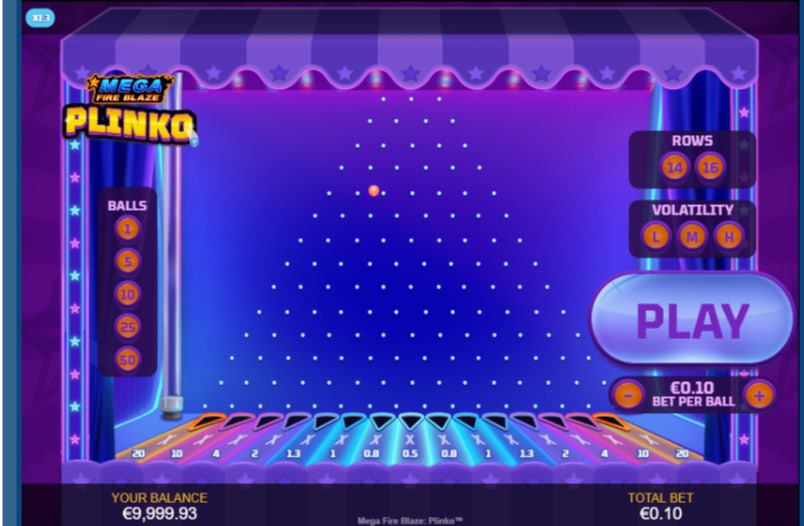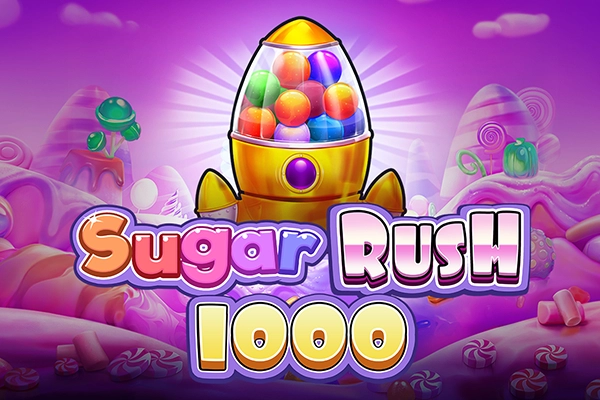Mega Fire Blaze: Plinko by Playtech adapts the classic Plinko prize drop concept into an online game format with a vibrant neon arcade atmosphere. Players release balls onto a selectable 14 or 16-row pinned pyramid grid. The core interaction involves watching the ball navigate the pegs via simulated physics to land in prize slots below. A distinct characteristic is the player’s ability to choose Low, Medium, or High volatility, directly altering the multiplier values and risk profile of the grid. This title integrates Playtech’s well-known Fire Blaze and Mega Fire Blaze hold-and-respin style bonus rounds. These bonus features activate when a ball lands in specially marked slots, offering chances for accumulated cash prizes and fixed jackpots. The game’s theoretical RTP varies between 95.41% and 96.44% depending on the chosen settings. It provides a different gaming dynamic compared to standard reel-based slots, emphasizing configurable probability and visual path anticipation.
Playtech steps away from conventional reel-based designs with Mega Fire Blaze: Plinko, integrating the familiar gravity-driven Plinko mechanic with their established Fire Blaze jackpot feature series. This title presents a different kind of engagement, shifting focus from paylines and symbol combinations to probability paths and configurable risk parameters. It caters to players who appreciate direct cause-and-effect gameplay, albeit governed by physics simulation, and those interested in exploring the Fire Blaze system outside its typical slot machine environment. The game primarily targets individuals seeking free online entertainment or those wishing to dissect game mechanics before potential real-money engagement.
The fundamental premise is straightforward: balls are released from the top of a pegged, pyramid-shaped field, deflecting downwards until they settle into prize multiplier slots at the base. However, the layers of player-adjustable settings and the inclusion of two distinct feature modes elevate it beyond a simple pachinko simulation. This analysis will dissect the game's structure, configurable elements, feature triggers, and overall operational flow.

Core Gameplay Mechanics and Ball Progression
The central interaction involves observing a ball's descent through the pin field. Unlike traditional slots where outcomes are determined by RNG upon hitting ‘spin', here the result visually unfolds as the ball caroms off pegs. The path is determined by a physics engine, creating a simulation of chance based on the starting drop point (which is typically fixed or centrally oriented) and the interactions with the pegs. Player agency is primarily exercised before the ball drop, in setting up the game's parameters.
Once a ball is released, its trajectory is subject to the randomized deflections caused by the matrix of pins. Each pin acts as a potential diversion point, altering the ball's downward path left or right. The density and arrangement of these pins, dictated by the selected row count, directly influence the probability distribution of the ball landing in specific slots at the bottom. The outer slots, typically holding higher multiplier values or feature triggers, are statistically harder to reach due to the pyramid structure guiding balls towards the center.
The game processes one ball drop at a time, even when multiple balls are purchased via the magazine feature. While balls might visually appear close or overlap during rapid succession drops (especially with larger magazines), their individual paths and final slot outcomes are calculated independently. They do not physically interact or collide with each other within the game's simulation. The result of each drop is determined solely by which prize slot the ball ultimately comes to rest in.
Player Configuration: Rows and Volatility Settings
A significant aspect differentiating this Plinko iteration is the ability to modify the core playing field and its associated payout structure. Players select two key parameters before initiating a drop:
Number of Rows: Options are typically 14 or 16 rows of pins. Increasing the rows makes the pyramid taller and wider at the base. This adjustment directly changes the number of prize slots available at the bottom and subtly alters the distribution path probabilities. A higher row count generally means a wider spread of potential outcomes.
Volatility Level: Players choose between Low (L), Medium (M), or High (H). This selection fundamentally reshapes the multiplier values assigned to the prize slots at the bottom. It doesn't change the pin layout (that's tied to Rows) but drastically alters the risk/reward profile of the game board.
The interplay between Rows and Volatility creates distinct payout landscapes:
14 Rows Configuration:
Low Volatility: Focuses on frequent, smaller wins. Multipliers might range from 0.5x to 20x, with values clustered towards the lower end near the center. (e.g., 0.5, 0.8, 1, 1.3, 2, 4, 10, 20). This setup minimizes risk but caps higher-end potential in the base game.
Medium Volatility: Introduces a broader range, including potential losses (multipliers below 1x) and the possibility of triggering the Fire Blaze (FB) feature. Values might look like 0.2, 0.5, 1, 1.4, 4, 7, FB, 100. The 100x slot represents a significant base game target.
High Volatility: Presents the most extreme distribution. Often includes a 0x slot (direct loss of stake for that ball), very low multipliers near the center, and significantly higher potential payouts on the edges, including the Mega Fire Blaze (MFB) trigger and potentially a large direct multiplier (e.g., 0, 0.2, 0.3, 2, 4, 14, MFB, 500). This caters to players seeking maximum potential variance per drop.
16 Rows Configuration: The increased number of rows further refines the distribution and changes the available multipliers and feature placements for each volatility level.
Low Volatility: Similar philosophy to 14 rows, but adjusted for more slots. Could include FB trigger and a high-end multiplier (e.g., 0.5, 0.9, 1.1, 1.2, 1.3, 1.5, 2, FB, 100).
Medium Volatility: Balances risk, potentially offering both FB and MFB triggers alongside a range of multipliers (e.g., 0.3, 0.5, 1, 1.2, 2, 5, 16, MFB, 500).
High Volatility: Maximizes the extremes for 16 rows. Can feature 0x slots, low central values, but potentially very high multipliers and both feature triggers positioned on the outer edges (e.g., 0, 0.2, 0.3, 1.5, 4, 10, FB, MFB, 2000).
Understanding these configurations is essential. The choice of Rows and Volatility directly dictates the mathematical model the player is engaging with for each ball drop. If the interaction between row count, volatility, and the resulting prize distribution seems intricate, accessing the Mega Fire Blaze: Plinko demo allows for examination of the official game help file (usually accessed via an ‘i' or ‘?' icon) for precise payout tables corresponding to each configuration. This allows for informed decisions based on risk preference before committing any virtual or real currency.
The Betting System and Magazine Feature
Betting is structured on a ‘Bet Per Ball' basis. Players use ‘+' and ‘-‘ controls to set the stake value for each individual ball released. The total cost for initiating play depends on this value and the selected ‘Magazine' size.
The Magazine feature allows players to pre-purchase a batch of balls (1, 5, 10, 25, or 50) for consecutive drops at the currently selected Bet Per Ball. The Total Bet displayed reflects the cost of the entire magazine (Bet Per Ball x Number of Balls). Selecting a magazine size commits the player to that number of drops at the fixed bet; settings cannot be changed mid-magazine.
Single Ball Play (Magazine Size 1): Offers maximum flexibility, allowing players to adjust Rows, Volatility, and Bet Per Ball before each drop. Suitable for testing configurations or playing cautiously.
Magazine Play (5-50 Balls): Provides a more automated experience. Balls are launched sequentially with a brief pause between each. A counter displays the remaining balls in the current magazine. This mode is convenient for players who have settled on a configuration and wish to observe outcomes over a series of drops without constant clicking. For larger magazines (25/50), the visual tube holding the balls refills dynamically as they are launched.
The primary trade-off with the magazine feature is convenience versus the ability to react immediately to results or change strategy between individual drops.
Fire Blaze (FB) Feature Deep Dive
Landing a ball in a prize slot designated ‘FB' activates the Fire Blaze feature. This shifts the gameplay to a secondary hold-and-spin style bonus round, using the same Bet Per Ball value that triggered the feature.
The Fire Blaze feature screen presents a grid of 18 empty slots, arranged loosely in columns. Below this grid are three ‘boxes', and alongside the grid are four fixed jackpot prizes: MINI (X20 bet), MINOR (X100 bet), MAJOR (X500 bet), and GRAND (X2000 bet).
Initialization: The round begins with 3 random cash prize symbols (values typically up to 5x the triggering bet) placed on the 18-slot grid. The three boxes below the grid are assigned either a random win multiplier (X2, X3, or X5) or a ‘Star' icon. The player is awarded 3 initial spins.
Spin Mechanic: Each spin attempts to land additional cash prize symbols (values ranging from 1x to 50x bet) in the empty slots. Landing at least one new cash prize symbol locks it in place and resets the spin counter back to 3. If a spin yields no new symbols, the counter decreases by 1.
Feature Conclusion: The round ends when either all 18 slots are filled with prize symbols or the spin counter reaches zero.
Payout Calculation:
All visible cash prize values on the grid are summed up.
Column Completion Bonus: If all 6 slots directly above a box containing a win multiplier (X2, X3, X5) are filled, the sum of the cash prizes in the two columns directly above that multiplier box is multiplied by that factor.
Star Icon / Jackpot Bonus: If all 6 slots directly above a box containing a Star icon are filled, the player wins the sum of the cash prizes in the two columns directly above that star PLUS one of the four fixed jackpots (Mini, Minor, Major, Grand). The specific jackpot awarded is determined randomly upon achieving the Star column completion.
If columns above multipliers or stars are not completely filled (5 prizes or fewer), the cash prizes in those columns are simply added to the total without modification.
The Fire Blaze feature offers a distinct gameplay loop focused on filling the grid and leveraging column completions for enhanced payouts or jackpot chances. The reset mechanic provides the potential for extended rounds.
Mega Fire Blaze (MFB) Feature Deep Dive
Triggered by landing a ball in an ‘MFB' designated prize slot, the Mega Fire Blaze feature is essentially a significantly larger and potentially more potent version of the standard Fire Blaze round. It operates under similar principles but with an expanded scope.
The MFB screen features a larger grid of 36 slots. Below this grid are six ‘boxes', and crucially, the four fixed jackpot prizes (MINI X20, MINOR X100, MAJOR X500, GRAND X2000) are displayed above the grid, associated with specific column sets.
Initialization: The round starts with 6 random cash prize symbols (up to 5x bet) pre-placed on the 36-slot grid. The six boxes below the grid display either random win multipliers (X2, X3, X5) or Star icons. The player receives 3 initial spins.
Spin Mechanic: Identical to the FB feature: spins attempt to land new cash prizes (1x to 50x bet) or blanks. Landing any new cash prize locks it and resets spins to 3. No new prizes decrease the spin count.
Feature Conclusion: Ends when all 36 slots are filled or spins run out.
Payout Calculation:
All cash prizes on the grid are summed.
Column Completion Bonus (Multipliers): Filling all 6 slots directly above a box with a win multiplier (X2, X3, X5) multiplies the prizes in the two columns above it by that factor.
Column Completion Bonus (Stars / Jackpots): Filling all 6 slots directly above a box with a Star icon awards the sum of cash prizes in the two columns above it PLUS the fixed jackpot prize (Mini, Minor, Major, or Grand) that is displayed directly above those associated columns on the main MFB screen. Unlike the standard FB feature, the jackpot potential is tied spatially to the Star column location.
Incomplete columns above multipliers or stars contribute their face-value cash prizes to the total.
The MFB feature amplifies the hold-and-spin concept with a larger grid, more initial symbols, and a slightly different mechanism for awarding the fixed jackpots, directly linking them to specific column completions above Star icons.
Atmosphere, Visual Presentation, and Interface Elements
Mega Fire Blaze: Plinko adopts a vibrant, neon-infused aesthetic reminiscent of classic game shows or arcade attractions. The primary color palette revolves around blues, purples, and pinks, with bright highlights for prize values and feature triggers. The animation of the ball falling and interacting with the pins is fluid, providing clear visual feedback on its path. Landings in prize slots are accompanied by distinct visual effects and likely corresponding sounds (though sound design specifics require direct play), differentiating between low, medium, and high multiplier wins.
The interface is cleanly laid out. Player controls (Rows, Volatility, Bet Per Ball, Magazine Size, Play) are grouped logically, primarily on the right and left sides of the screen. Balance and Total Bet information are clearly displayed at the bottom. A useful, though non-interactive, feature is the History widget usually located at the top. This displays the multiplier outcomes of recent ball drops, color-coded for value (e.g., blue for low, purple for mid, yellow for high, red for very high/feature triggers). This provides a quick visual summary of recent performance trends within the session.
The overall presentation is functional and engaging without being overly complex. It effectively communicates the game state and focuses attention on the ball's descent and the potential outcomes arrayed at the bottom. The visual design complements the relatively straightforward yet potentially high-variance nature of the gameplay.

Understanding Potential Outcomes and Game Profile
Playtech specifies a theoretical Return to Player (RTP) range for Mega Fire Blaze: Plinko, typically between 95.41% and 96.44%. This variability likely stems from the player's choices in Rows and Volatility settings, as different configurations possess distinct mathematical expectations. It's important to remember RTP is a long-term statistical calculation and doesn't predict short-term results.
The game also states a maximum win limit per single ball drop, often cited at 5,000x the Bet Per Ball. This likely refers to the highest possible multiplier achievable in the base game (seen in configurations like 16 Rows / High Volatility) or potentially a cap reached during the feature rounds, although features calculate winnings based on accumulated prizes and jackpots.
Mega Fire Blaze: Plinko presents an interesting deviation from standard slot gameplay. Its appeal lies in the visible physics-based probability, the significant player control over the game's risk profile via Rows/Volatility settings, and the integration of the layered Fire Blaze features. It offers a different kind of suspense, focused on the ball's path rather than spinning reels. The customizable volatility makes it potentially suitable for a range of player preferences, from those favoring lower-risk, steady play to those seeking high-variance potential through the feature triggers and extreme multiplier slots found in High Volatility modes. Its structure makes it a compelling option for players searching for free demo slots to analyze probability mechanics or for experienced players familiar with the Fire Blaze system looking for a novel implementation.













